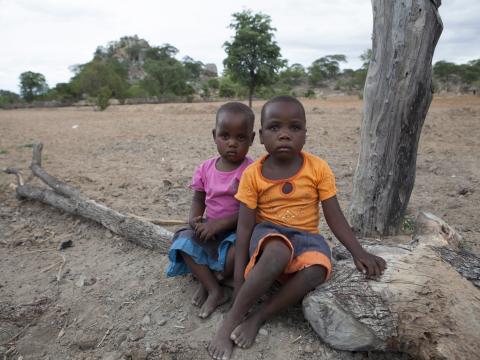In Lesotho, AIDS and malnutrition are a deadly combination

By: Atang Likotsi, Communications Officer, World Vision Lesotho
Like all little girls, Mia, 4, needs a good, healthy start in life. But beyond that there are many special things about Mia. She loves to sing and stamp her feet to the rhythm of songs with the other girls in her village. She is not frightened of strangers, running straight up to us as if she has known us forever. She is bilingual, chattering away both in Sesotho and Sethepu, the languages spoken in south and south-eastern Lesotho. She is friendly and trusting with a radiant smile.
Another thing makes Mia special – she is HIV positive. Ten years ago, this would have been one of the worst starts possible for a young child, but nowadays, with drug supply and child-appropriate dosage gradually improving, she has a chance to live a long and normal life. But she faces one more, overwhelming challenge – malnutrition.
Mia’s parents struggle to keep their children well nourished because they cannot grow their own food, nor work regularly or receive good wages. Her mother, is out all day long selling clothes from the street. Often she is home late, and the family wait for her to put food on the table.
“That is my home.” Mia points out to two buildings across a stream sheltered beneath closely grown trees. “My mother is not home now. She is going to arrive very late.”
Mia’s father, greets us warmly and walks us to the dark rondavel, furnished with two wooden benches.
In most rural communities, Basotho folk still uphold the culture of offering a visitor water to wash hands, and then food. I pass a joke, “Now that we are seated, Mia, you can treat us to something delicious to eat. What have you cooked..?”
She smiles shyly and looks at her father. “I have not cooked. It is my mother who cooks when she comes back from work.”
While Mia fetches her health record for us to view, her mother finally arrives home, tired and hungry herself.
“I never walk less than 10km a day travelling from one village to the next village selling clothes. I earn commission from every sale I make. This comes at the end of the month. It is barely enough to take care of my three daughters including Mia who is HIV positive,” she narrates.
Mia was diagnosed HIV positive in 2010, a year after she was born. Her mother said her daughter was born normal and healthy.
“When Mia was found to be HIV positive, her CD4 count was 900. The doctor advised us to take for treatment right away,” she explained. From that time, though her count has improved, Mia has always been underweight.
Mia’s weight has increased steadily since she started receiving corn soya blend from World Vision’s nutrition program and for a few months now it has remained steady.
“We are very thankful for the corn soya blend “super-cereal” that Mia receives. That comes in handy especially when I have no idea what I can do to feed her and her sisters.”
For now, Mia is lucky. She plays and runs like the other girls, is optimistic and happy. But to reach all the children like Mia in Lesotho will take more than luck. The Child Grants programme launched in 2009 is still not reaching some of the most vulnerable families, including those affected by HIV and AIDS. An estimated 41,000 children are living HIV positive, and 39% of Lesotho’s under-fives are moderately or severely stunted.
It is a tragic combination; if Lesotho cannot find the solution soon, the kingdom is extremely unlikely to meet its MDG targets for child survival.